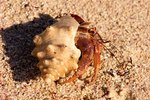
Hermit crabs are diggers by nature. They dig into their substrate for a number of reasons. Not all hermit crabs dig for the same reasons, and a number of environmental factors determine whether and how often crabs dig. Molting, or shedding the exoskeleton, is only one reason why a hermit crab might dig.
Ready to Molt
One of the primary reasons that hermit crabs may dig is in preparation for molting. Hermit crabs will dig themselves holes in the substrate for protection from potential predators, including other crabs that might cannibalize them in their vulnerable state. In addition, hermit crabs require the darkness that digging beneath the substrate provides in order to trigger the hormone that initiates the molting process.
Stress Reduction
If hermit crabs are stressed or feel unsafe, they will often dig into the substrate for security, isolation or comfort purposes. Crabs new to an enclosure or who have been brought into a home for the first time may dig below the substrate to relieve stress or to rest away from unfamiliar stimuli. Additionally, some species of hermit crabs just like to spend their time digging, for no specific reason.
Adjusting the Thermostat
If their enclosures aren't quite warm or cool enough for comfort, hermit crabs will dig into the substrate in order to increase their body temperatures. Ensure that your hermit crab's enclosure remains in an optimal temperature range. The ideal temperature for most hermit crabs is between 70 and 75 degrees Fahrenheit, but for best health, the temperature should not drop below 72 degrees Fahrenheit for more than a day or two.
Finding Moisture
Appropriate humidity is just as essential to a crab's health as temperature, so a hermit crab may sometimes dig into the substrate in search of moisture. In their natural habitat, crabs have access to moist soil and sand. If the humidity in the enclosure is not high enough, a crab may seek the moisture that substrate is holding on to.
What to Do With a Digging Crab
If your crab is spending his time digging in hi substrate, the best course of action is to let him be. It is important to monitor the time that your hermit crab spends under the substrate, so document when he dug himself a hole. In four weeks, if your crab has not emerged, you can gently move some substrate off him to make sure he is not dead. If he appears to be molting, carefully re-cover him and continue to leave him alone.
References
Photo Credits
-
Jeffrey Hamilton/Digital Vision/Getty Images




